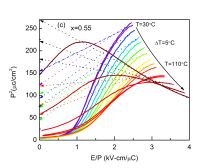Flattening of free energy profile and enhancement of energy storage efficiency near morphotropic phase boundary in lead-free BZT-xBCT
| Abstract | We have synthesized lead-free BZT-xBCT (x = 0.45, 0.50 and 0.55) compositions near morphotropic phase boundary (MPB) using sol-gel technique. Here, we have reported the compositional effect of BCT concentration on structure, surface morphology, dielectric properties and energy storage capacity of BZT-xBCT ceramics. Scanning electron microscopy analysis suggests that the smallest grain size is found for the x = 0.55 composition. The dielectric constant vs temperature measurement indicates that the addition of BCT causes lowering of ordering temperature. In addition, we have performed modified Curie-Weiss fitting to reveal the microscopic behaviour of the synthesized compositions and found Curie constant ‘C’ as 1.3×〖10〗^6, 2.1× 〖10〗^7 and 1.7×〖10〗^7 for x = 0.45, 0.50 and 0.55 compositions, respectively, and diffusion coefficient 1.4 ≤ γ ≤ 1.99. Polarization (P) vs electric field (E) curves collected at series of temperature, insights that compositions x = 0.50 and 0.55 exhibit slimmer P-E profiles, which causes lowering of remnant polarization (Pr) and hysteresis loss of dielectric system and ensures their suitability in area of pyroelectric based energy harvesting. We also estimated the energy storage density W ~ 189 mJ/cm3 and high discharge efficiency 𝛈 ~ 75.6% for BZT-0.55BCT ceramic composition. Further, we have employed Arrott plot approach to reveal the involved mechanism of Landau Free Energy flattening in BZT-BCT composition at MPB. It is considered that Landau Free Energy flattening plays key role in exhibiting high electro-mechanical response at MPB. On the basis of findings from dielectric spectroscopy and Arrott plot scheme, we argue that energy flattening phenomenon and high electromechanical response in BZT-xBCT system is achieved via active “polarization rotation mechanism”, instead of “polarization extension”. Our study emphasizes that BCT rich BZT-0.55BCT ceramics are suitable for high energy storage density application. |
| Faculty |
Sanjeev Kumar
|
|
sanjeev@pec.edu.in
|
|
| Collaborations | Dr. O.P. thakur, Solid State Physics Laboratory, New Delhi |
| More Information |







